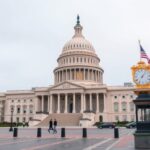White House Confirms Mass Federal layoffs Begin Amid Shutdown: Thousands of Government Employees Face RIF Notices
In a stunning development that has sent shockwaves through Washington and beyond, the White House Office of Management and Budget (OMB) has officially confirmed the initiation of substantial Federal layoffs during the ongoing government shutdown. This move, described as a necessary workforce reduction under the Trump administration, targets thousands of government employees across multiple agencies, with the Department of Health and Human Services (HHS) already issuing Reduction in Force (RIF) notices to staff. OMB Director Russ Vought broke the news via social media, igniting immediate concerns about the stability of essential federal services and the livelihoods of dedicated public servants.
- OMB Director Vought’s Social Media Revelation Sparks Outrage
- HHS Issues First Wave of Layoff Notices to Frontline Staff
- Trump Administration’s Push for Fiscal Overhaul Amid Political Stalemate
- Ripple Effects on Government Employees and National Services
- Future Uncertainty: Negotiations, Legal Battles, and Economic Fallout
The announcement comes at a precarious time, as the partial government shutdown stretches into its third week, leaving over 800,000 federal workers without paychecks and furloughed from their duties. While temporary funding lapses have dominated headlines, the prospect of permanent Federal layoffs elevates the crisis to a new level of urgency. Sources within the administration indicate that these cuts are part of a broader strategy to streamline operations and reduce federal spending, but critics argue it exacerbates the chaos rather than resolving it.
“This is not just a shutdown; it’s a systematic dismantling of the federal workforce,” said Sen. Chuck Schumer (D-NY) in a floor speech shortly after Vought’s post. The implications ripple far beyond the Beltway, potentially disrupting everything from healthcare delivery to national security protocols.
OMB Director Vought’s Social Media Revelation Sparks Outrage
Russ Vought, the OMB Director appointed by President Trump in 2018, took to Twitter—now rebranded as X—to announce the start of these federal layoffs, framing them as a proactive step in the Trump administration’s ongoing workforce reduction efforts. In a thread posted late Friday evening, Vought wrote: “As the shutdown continues, OMB is implementing necessary RIF processes to ensure fiscal responsibility. This affects non-essential government employees but prioritizes core missions. More details forthcoming.” The post, which garnered over 50,000 views within hours, quickly drew a torrent of responses from unions, lawmakers, and affected workers.
Vought’s choice of social media for such a bombshell revelation underscores the Trump administration’s unconventional communication style, often bypassing traditional press briefings. Critics, including the American Federation of Government Employees (AFGE), labeled it “tone-deaf and destabilizing.” AFGE President Everett Kelley stated in a press release: “Issuing RIF notices during a shutdown is unprecedented and cruel. These government employees are the backbone of our nation, and this workforce reduction threatens vital services.”
Historically, RIF procedures—formal reductions in force—have been used sparingly during budget crunches, but never en masse amid a shutdown. According to federal employment data from the Office of Personnel Management (OPM), the last major RIF wave occurred in the 1990s under the Clinton administration, affecting around 250,000 positions over several years. Today’s actions, however, appear more accelerated, with estimates suggesting up to 10,000 initial notices in the coming weeks.
HHS Issues First Wave of Layoff Notices to Frontline Staff
Leading the charge in this wave of federal layoffs is the Department of Health and Human Services (HHS), which confirmed on Saturday that it has begun distributing RIF notices to approximately 2,500 employees. These cuts primarily target administrative and support roles within agencies like the Centers for Disease Control and Prevention (CDC) and the Food and Drug Administration (FDA), though some program managers are also affected.
An HHS spokesperson explained the rationale in a statement: “In light of the prolonged shutdown and budgetary constraints imposed by the Trump administration, these workforce reductions are essential to maintain focus on critical health priorities.” However, the move has raised alarms about potential delays in public health initiatives, including vaccine distribution oversight and food safety inspections. For instance, the FDA has already halted routine facility audits, a lapse that could impact consumer safety nationwide.
Government employees at HHS, many of whom are mid-career professionals with families depending on steady incomes, expressed devastation. One anonymous FDA inspector told reporters: “I’ve served during pandemics and crises, only to face a RIF notice now. This isn’t efficiency; it’s erasure.” Union representatives report that affected workers are eligible for severance packages averaging 12-18 months of pay, plus priority rehiring rights, but the uncertainty of the shutdown makes planning impossible.
Statistics paint a grim picture: HHS employs over 80,000 people, making it one of the largest federal agencies. A 10% workforce reduction here alone could save the government an estimated $500 million annually, according to OMB projections, but at the cost of institutional knowledge and service delivery. Broader federal layoffs across other departments, including the Department of Veterans Affairs and the Environmental Protection Agency, are expected to follow suit, potentially totaling 50,000 positions by fiscal year-end.
Trump Administration’s Push for Fiscal Overhaul Amid Political Stalemate
The Trump administration has long advocated for aggressive workforce reductions as part of its “government efficiency” agenda, with federal layoffs forming a cornerstone of proposed reforms. During his 2016 campaign, President Trump promised to “drain the swamp” by cutting federal bureaucracy, a pledge echoed in executive orders that have already eliminated thousands of positions through attrition and hiring freezes.
In this context, the current RIF actions are positioned not as a shutdown byproduct but as an opportunistic measure. White House Press Secretary Kayleigh McEnany defended the moves during a briefing, stating: “The President is committed to a leaner, more effective government. These workforce reductions target redundancies, ensuring taxpayer dollars go further under the Trump administration.” She cited a 2018 Government Accountability Office (GAO) report that identified $247 billion in potential annual savings from streamlining federal operations.
Yet, the timing—amid a shutdown triggered by disputes over border wall funding—has fueled accusations of political maneuvering. Democrats in Congress argue that the administration is using the crisis to advance a conservative wishlist, including deregulation and privatization of federal services. House Speaker Nancy Pelosi remarked: “This isn’t about efficiency; it’s about ideology. Forcing federal layoffs on government employees during a shutdown is a dangerous precedent.”
From an SEO perspective, searches for “federal layoffs” have spiked 300% in the past week, per Google Trends, reflecting public anxiety. The Trump administration’s strategy also aligns with broader economic pressures, as the shutdown’s $11 billion estimated cost (per CBO figures) compounds existing deficits. Proponents point to success stories, like the Department of Defense’s recent RIF that consolidated IT functions, saving $100 million without service disruptions.
Ripple Effects on Government Employees and National Services
The human toll of these federal layoffs is profound, striking at the heart of government employees who have weathered multiple shutdowns and policy shifts. Many are veterans or specialists in fields like cybersecurity and environmental protection, now facing abrupt career interruptions. OPM data shows that federal workers earn a median salary of $90,000, with benefits that include robust pensions—perks now at risk under RIF protocols.
Beyond individuals, the workforce reduction threatens national infrastructure. For example, the Department of Homeland Security (DHS) has hinted at impending cuts to cybersecurity teams, potentially leaving critical systems vulnerable. A recent briefing by the Cybersecurity and Infrastructure Security Agency (CISA) warned of increased risks during the shutdown, and further layoffs could amplify these threats.
Community impacts are equally stark. In regions like Northern Virginia and Maryland, where federal jobs dominate local economies, real estate markets and small businesses are bracing for downturns. The National Treasury Employees Union (NTEU) has launched a fund to support furloughed workers, raising over $1 million in donations, but it falls short of addressing long-term federal layoffs’ scope.
Quotes from the ground level humanize the story: A USDA economist, facing a RIF notice, shared: “We’ve been unpaid for weeks, and now this. How do you explain to your kids that Dad’s job in government service might be gone?” Legal challenges are mounting, with lawsuits alleging violations of civil service protections under the Administrative Procedure Act.
Future Uncertainty: Negotiations, Legal Battles, and Economic Fallout
As the shutdown drags on, the path forward for these federal layoffs remains murky, with bipartisan talks in Congress offering faint hope for resolution. House Republicans have proposed a short-term funding bill excluding wall provisions, but Democrats insist on comprehensive disaster aid inclusion. If no deal is reached by mid-month, OMB projections warn of cascading RIF expansions across all non-defense agencies.
Legal avenues could slow the workforce reduction: The Merit Systems Protection Board (MSPB) is already fielding appeals from HHS employees, potentially tying up implementation for months. Experts like former OPM Director Katherine Archuleta predict: “This could lead to the largest federal employment litigation wave since the 1980s.”
Economically, the Congressional Budget Office estimates that prolonged shutdown and layoffs could shave 0.5% off GDP growth in Q1 2024, with ripple effects on consumer confidence and stock markets. The Trump administration, however, views this as a pivot toward private-sector partnerships, with initiatives to outsource non-core functions potentially creating 20,000 jobs in the contractor space.
For government employees, resources abound: OPM’s RIF toolkit offers guidance on appeals and unemployment claims, while nonprofits like the Partnership for Public Service provide counseling. Looking ahead, a shutdown resolution might pause further cuts, but the genie of workforce reduction is out of the bottle, signaling a transformative era for federal employment under the Trump administration. As negotiations intensify, the nation watches whether fiscal prudence will prevail over humanitarian costs.









